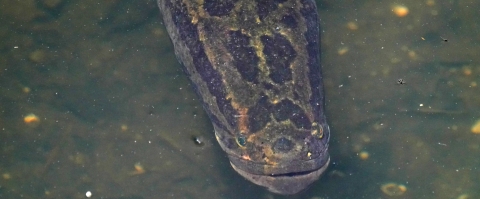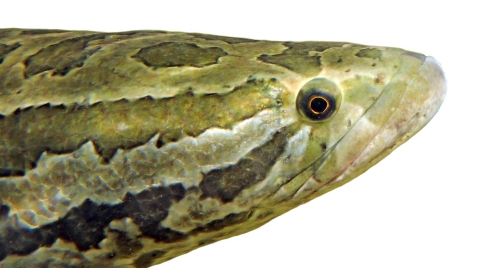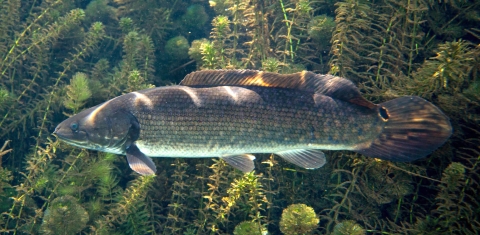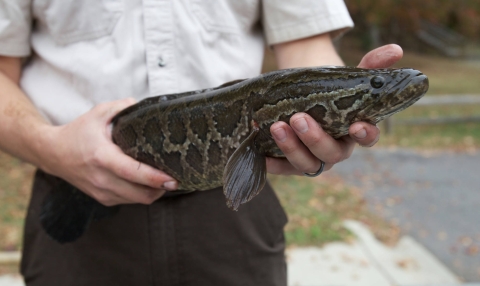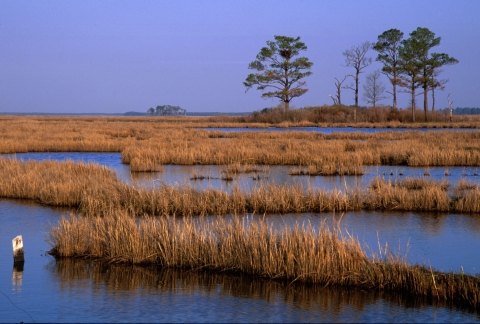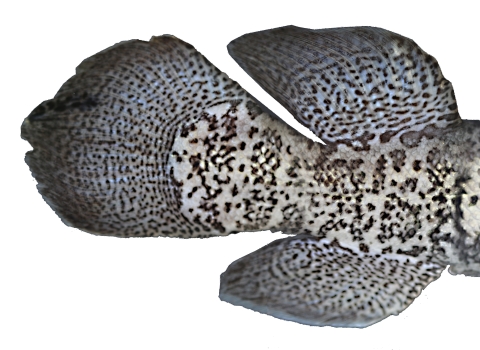Crofton, Maryland is a non-descript, suburban community equidistantly located between Baltimore and Washington D.C. It’s also the epicenter of one of the biggest fish stories of the early twenty-first century. On a summer evening in 2002, while fishing in a small pond behind the local post office, an angler caught a large fish unlike any he’d ever seen. In time, this catch would tip off fisheries managers to one of the most notorious invasive species invasive species
An invasive species is any plant or animal that has spread or been introduced into a new area where they are, or could, cause harm to the environment, economy, or human, animal, or plant health. Their unwelcome presence can destroy ecosystems and cost millions of dollars.
Learn more about invasive species in pop culture, spawn a wave of paranoia across the country, and even result in the production of three feature-length horror films. Now, nearly two decades after the Crofton encounter, we have a chance to reflect on the impacts of a complicated fish and one of North America’s most infamous non-natives: the snakehead.
The species pulled from the Crofton pond was a Northern Snakehead (Channa argus), one of three snakehead species introduced to U.S. waters from other areas of the world. Humans have also helped the Bullseye Snakehead (C. marulius) find its way to southern Florida and the Striped Snakehead (C. striata) to Hawaii in the 1800s. Native to Russia, China, and the Korean Peninsula, the Northern Snakehead is the only one of the dozens of species of Channa well-suited to survive in America’s temperate waters.
Snakeheads: The Perfect Invasive Species?
With large mouths full of pointed teeth and eyes that sit near the top of flat, scaly heads, it’s easy to guess how snakeheads got their name. In the case of the Northern Snakehead, even the patterns along their scales are reminiscent of a boa or python.
Snakeheads lie in wait at the bottom of shallow, slow-moving, weedy waters. When their quarry strays too close, they engage their muscular bodies and strike like torpedoes. In this way they’re like some other North American ambush fishes, including Bowfin and pickerels. And sometimes they’re misidentified as such.
Not a snakehead (it's the native Bowfin):
A snakehead (note the much longer anal fin and no dot on the tail compared to the bowfin above):
In addition to being able to eat relatively large food items, snakeheads are generalists that will eat a variety of available prey including other fish, reptiles, amphibians, and bugs. These same characteristics also seriously concerned fisheries biologists upon the species’ arrival who feared this new predator could destroy popular bass and native shad fisheries throughout the region by outcompeting and preying upon these popular sportfishes.
Snakeheads are equipped with other traits that alarmed both fisheries managers and the public. Whereas many species, like Largemouth Bass, spawn once per year, Northern Snakeheads can spawn multiple times in a season. Both males and females are known to aggressively care for their eggs and young.
They’re also obligate air breathers, meaning they must gulp air to survive. This is a rare trait among fishes and allows snakeheads to use stagnant, low oxygen waters that aren’t suitable for other species.
“You’re not gonna find any other fish, if any self-respecting fish, in 95-degree water in the middle of August that’s a foot deep. But you’ll find snakeheads there.” — John Odenkirk, Virginia Department of Wildlife Resources
This ability, plus being exceptionally slimy, allows these hearty fishes to survive outside of water for days at a time. Further, some snakeheads have been known to wiggle their bodies and move overland from one waterbody to another. However, this ability to “walk” is much less extreme than was often portrayed in the media after the early days of the snakehead’s arrival, particularly in the case of the Northern Snakehead.
All these traits rolled into a single fish suggested that the Northern Snakehead might be the perfect invasive species that, left uncontrolled, would unleash untold havoc on inland fisheries throughout the region. Biologists quickly descended upon the Crofton pond and used rotenone, a standard plant-based piscicide to kill all the snakeheads. To their dismay, thousands of juvenile snakeheads were found, indicating that the relatively few adults which had been originally released into the pond had successfully reproduced.
The Public Reacts
In response, the Northern Snakehead received much attention in the media as part of an attempt to quell its spread, with particular interest in keeping the fish from settling in major coastal river systems, like the Potomac. Officials encouraged anglers to report, target and kill snakeheads on their own or through formal snakehead roundups.
One way snakeheads spread new waters is by following freshets over the “salt wedge” where rivers become tidal. During storms and hurricanes, snakeheads ride the influx of freshwater downriver over the denser saltwater to new areas. Once the floodwaters recede, snakeheads look for the nearest freshwater tributary and follow it upstream.
Although there was cause for alarm among fisheries biologists seeking to both preserve existing fishing opportunities and conserve native fishes, the narrative described by mainstream media fostered hysteria and garnered fascination across the country. For a time, some local residents were hesitant to let their children or pets near the water’s edge for fear that this new snake fish would drag them to a watery death. Terms used to describe the introduced species included “frankenfish,” “fishzilla,” “devilfish,” and a “nightmarish creature from Asia.” Researchers did their best to dispel rumors and separate fact from fiction, but studying fish takes years and in this time no fewer than three separate horror films about the snakehead invasion were released between 2004 and 2006.
Despite more media coverage than any fisheries agency could reasonably hope for and the recruitment of many passionate anglers fighting for the cause, Northern Snakeheads persisted and eventually spread throughout the Potomac River.
Fishing for Snakeheads
The snakehead has garnered support as a sportfish in its own right. Anglers who targeted snakeheads found that it had many desirable characteristics, including its aggressive, predatory nature and willingness to hit a variety of live and artificial baits. Living in shallow waters, the strikes (especially those on topwater lures) make for a high-energy experience, perfect for an angler looking to film their trip. In recent years the snakehead has attracted a large contingent of kayak anglers seeking to target the species in ideal habitats that many motored boats cannot access. People sometimes travel from great distances to participate in snakehead tournaments, and some have taken to catch-and-release practices to conserve the snakehead fishery for future enjoyment. However, anglers are prohibited from introducing this fish to new waters; fish kept for consumption must be dispatched immediately upon landing.
On the other end of the spectrum, some hunters/anglers prefer to target snakeheads with bow and arrow (a technique called “bowfishing”) and, in some cases, even sell their catches commercially. And when the long, firm, white and flaky fillets finally hit the dinner table, the meat can be enjoyed by even those who don’t typically like eating fish.
“It went from being sort of a cult classic to the hottest thing in fishing, because a true snakehead aficionado hook and line person is only going to be able to really get into good snakehead fishing in a kayak.”
Snakeheads: it’s complicated
The complexity of fisheries, and of ecosystems more broadly, can often go unappreciated. Even with the best available information, it can be quite challenging to predict how a complex system will respond to change (like the introduction of a new species). In some cases, there may not be a noticeable impact, while others systems and species may not fare so well. And it can take years to play out.
“We don’t know what those impacts are going to be. They’re going to be different in every single watershed they show up in.” — Josh Newhard, Maryland Fish and Wildlife Conservation Office
Two decades since being first documented in Crofton, the range of the Northern Snakehead has spread north to New York, south to Virginia, and even across the Chesapeake Bay to Maryland’s Eastern Shore. They’ve also been documented in several other states, though many of these observations were isolated occurrences. Upon initial inspection, it might seem as though this snakehead battle was lost. After all, with their particular set of skills, snakeheads must have been able to prey upon and outcompete sportfish like the Potomac’s coveted Largemouth Bass. After nearly two decades in the Potomac system, scientists found that generally good environmental conditions have allowed both species to thrive and appear to be operating independently of one another.
Fisheries biologists have, however, noticed declines in fish catches in the waters around Blackwater National Wildlife Refuge in the Chesapeake Bay watershed (below) since snakeheads showed up, indicating possible connections/negative impacts.
This can make it difficult for anglers to know how to feel when they find a snakehead on the end of their line. And it can put fisheries managers in a tricky spot, with strong arguments being made by their stakeholders for a spectrum of management options. The rise in popularity of the snakehead among some fishing circles, coupled with declining catches from increased pressure, have put Northern Snakeheads at the middle of a nuanced discussion and debate around the future of this fish.
With human preferences constantly evolving, fisheries managers are often faced with making decisions that straddle the intersection of risk and reward, and that span across a spectrum of values and sentiments that can evolve through time. Parallel efforts to benefit native fishes (like reconnecting migration corridors to improve fish passage fish passage
Fish passage is the ability of fish or other aquatic species to move freely throughout their life to find food, reproduce, and complete their natural migration cycles. Millions of barriers to fish passage across the country are fragmenting habitat and leading to species declines. The U.S. Fish and Wildlife Service's National Fish Passage Program is working to reconnect watersheds to benefit both wildlife and people.
Learn more about fish passage ) are sometimes at odds with invasive species control efforts (like preventing snakeheads from moving into new areas in Susquehanna River or Sea Lampreys accessing suitable spawning habitat in Great Lakes tributaries).
Other separate examples of evolving angler preferences include a growing microfishing community with enthusiasm for very small nongame fishes, as well as “rough fish” circles who target fishes previously viewed as undesirable. Economically, all anglers contribute to fishing license sales and sporting equipment purchases. Revenue from the latter goes through the U.S. Fish and Wildlife Service’s Wildlife and Sportfish Restoration Program to the states for conservation of both native game and nongame fishes, their habitats, as well as to improving fishing and boating access points.
Most agencies draw the line between an invasive species and a non-native species based not only on its prevalence, but also on its likelihood to cause harm to humans, other native species, the environment, or the economy. Non-native gamefish from Largemouth Bass across the mid-Atlantic and New England to Pacific Salmon in the Great Lakes and European Brown Trout across the country continue to be popular, economically-important fishes. Snakeheads don’t pose a threat to humans despite the initial press, however understanding the scope of their ecological toll has yet to be fully understood given all the factors and time scales at play in complex systems like the Potomac and elsewhere.
A Tale of Caution
The saga of the snakehead in the mid-Atlantic should be viewed cautiously in other parts of the world. It is one thing to catch and release a fish into the water from which it came, but these fish (and fishes generally, as well as other live aquatic critters and plants) should NEVER be transported and released into new waters. Although some of the ecosystems discussed here appear to be handling the snakehead introduction to date, there are still a lot of unknowns surrounding the “what ifs?” that come with time, as well as with continued spread into waters with endangered fishes, or during times where environmental conditions aren’t as favorable for fishes in general.
“You can’t paint all invasives with one brush. We have to look at each one individually.” — John Odenkirk
In the meantime, there remains an open season on snakeheads throughout the mid-Atlantic. So, if you’re planning a trip to our nation’s capital, bring a rod, bring a kayak, bring some batter and a fryer, and get ready for a good time. Maybe even make a day trip to some water behind the Crofton post office, now listed as Walking Fish Pond on Google Maps, to glimpse for yourself where the whole story started.
We honor, thank, and celebrate the whole community — individuals, Tribes, States, our sister agencies, fish enthusiasts, scientists, and others — who have elevated our understanding and love, as people and professionals, of all the fish. In Alaska we are shared stewards of world renowned natural resources and our nation’s last true wild places. Our hope is that each generation has the opportunity to live with, live from, discover and enjoy the wildness of this awe-inspiring land and the people who love and depend on it.



